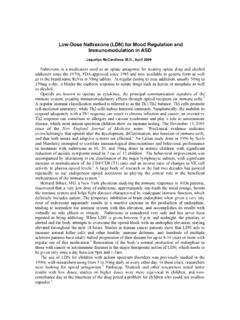Transcription of NEW ZEALAND DATA SHEET - Medsafe
1 NEW ZEALAND data SHEET Sevredol tablets June 2017 Page 1 of 12 SEVREDOL tablets Morphine sulphate 1 PRODUCT NAME SEVREDOL 10 mg and 20 mg tablets 2 QUALITATIVE AND QUANTITATIVE COMPOSITION Each tablet contains morphine sulphate 10mg or 20mg. Excipient with known affect: Lactose, anhydrous For full list of excipients, see section 3 PHARMACEUTICAL FORM SEVREDOL tablets are capsule shaped, biconvex, scored, film-coated tablets approximately 12 mm in length with the strength on one side and "IR" on the other side of the score line. The colours of the tablets are as follows: 10 mg blue and 20 mg pink. 4 CLINICAL PARTICULARS Therapeutic indications SEVREDOL tablets are indicated for the relief of both acute and chronic severe pain in adults and children aged three years and above.
2 Dose and method of administration Dose Adults and children over 12 years: SEVREDOL tablets should be given every four hours. The dosage is dependent upon the nature and severity of the pain, the patient's condition and their previous history of analgesic therapy. A patient initially presenting with severe and intractable pain will normally be started on SEVREDOL 10 mg every 4 hours. This dose should be increased every 4 hours until the patient is free of pain. At that stage the patient should be transferred onto a long acting morphine preparation. To do this, add the amount of morphine needed to completely relieve pain over a 24-hour period.
3 Divide this total in half, rounding up to nearest tablet strength and administer the long acting morphine preparation as a twice daily dose. The first dose of the long acting morphine preparation should be given with the last dose of SEVREDOL tablets. Any recurrence of pain will require an increase in the dose but not the frequency of the long acting morphine preparation. Breakthrough pain should be treated with SEVREDOL tablets, not extra long acting morphine. There is no upper dose limit for morphine sulphate tablets. Patients on chronic oral morphine therapy have been known to take in excess of 3000 mg/day with no apparent toxicity or addiction.
4 The dose of morphine used for individual patients must be that dose which completely eliminates their pain irrespective of how large it is. Patients receiving morphine sulphate tablets in place of parenteral morphine should be given a sufficiently increased dosage to compensate for the reduction in analgesic effects associated with orally administered analgesics. NEW ZEALAND data SHEET Sevredol tablets June 2017 Page 2 of 12 Paediatric population: 3-5 years: 5 mg 4 hourly. 6-12 years: 5-10 mg 4 hourly. Elderly: 5 mg 4 hourly increasing as necessary to completely relieve the pain. Method of administration: SEVREDOL tablets should be swallowed whole and not chewed unless half tablets are being used.
5 The tablets are film coated to mask the bitter taste of morphine and this masking effect is lost if the tablets are broken. SEVREDOL tablets are substitutable with oral morphine solution when titrating for pain relief or treating break through pain. Contraindications Morphine is contraindicated in patients with hypersensitivity to the active substance or to any of the excipients listed in section with known morphine sensitivity with acute hepatic disease. with respiratory depression, especially in the presence of cyanosis and excessive bronchial secretion. with acute alcoholism, with head injuries, in which intracranial pressure is raised.
6 During an attack of bronchial asthma with heart failure secondary to chronic lung disease. who are taking or have taken monoamine oxidase inhibitors (MAOIs) within the previous two weeks with paralytic ileus, acute abdomen, or delayed gastric emptying for use as a pre-operative medication. with pheochromocytoma, as morphine appears to increase catecholamine levels. with chronic pain not due to malignancy who have a prior history of substance abuse. Special warnings and precautions for use Respiratory depression and sedation The major risk of opioid excess is respiratory depression. Profound sedation, respiratory depression, coma, and death may result from the concomitant use of SEVREDOL with benzodiazepines or other CNS depressants ( , non-benzodiazepine sedatives/hypnotics, anxiolytics, tranquilizers, muscle relaxants, general anaesthetics, medicines with antihistamine-sedating actions such as antipsychotics, other opioids, alcohol).
7 Because of these risks, reserve concomitant prescribing of these drugs for use in patients for whom alternative treatment options are inadequate. Observational studies have demonstrated that concomitant use of opioid analgesics and benzodiazepines increases the risk of medicine-related mortality compared to use of opioid analgesics alone. Because of similar pharmacological properties, it is reasonable to expect similar NEW ZEALAND data SHEET Sevredol tablets June 2017 Page 3 of 12 risk with the concomitant use of other CNS depressant drugs with opioid analgesics (see Section Interactions with other medicines and other forms of interaction).
8 If the decision is made to prescribe a benzodiazepine or other CNS depressant concomitantly with an opioid analgesic, prescribe the lowest effective dosages and minimum durations of concomitant use. In patients already receiving an opioid analgesic, prescribe a lower initial dose of the benzodiazepine or other CNS depressant than indicated in the absence of an opioid, and titrate based on clinical response. If an opioid analgesic is initiated in a patient already taking a benzodiazepine or other CNS depressant, prescribe a lower initial dose of the opioid analgesic, and titrate based on clinical response. Follow patients closely for signs and symptoms of respiratory depression and sedation.
9 Advise both patients and caregivers about the risks of respiratory depression and sedation when SEVREDOL is used with benzodiazepines or other CNS depressants (including alcohol and illicit drugs). Advise patients not to drive or operate heavy machinery until the effects of concomitant use of the benzodiazepine or other CNS depressant have been determined. Screen patients for risk of substance use disorders, including opioid abuse and misuse, and warn them of the risk for overdose and death associated with the use of additional CNS depressants including alcohol and illicit drugs (see Section Interactions with other medicines and other forms of interaction).
10 Special risk patients Morphine should be given with caution or in reduced doses in patients with impaired kidney or liver function, biliary tract disorders, the elderly, and in patients with Addison's disease, hypothyroidism, prostatic hypertrophy, raised intracranial pressure, hypotension with hypovolemia, pancreatitis, severe chronic obstructive lung disease, severe cor pulmonale, severe bronchial asthma or respiratory depression or urethral stricture. Opioid analgesics such as morphine sulphate should be used with caution in patients with myasthenia gravis. Morphine may lower the seizure threshold in patients with a history of epilepsy.
















